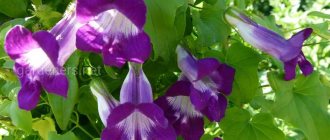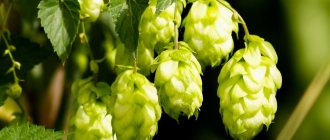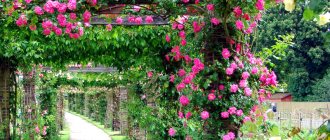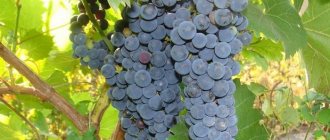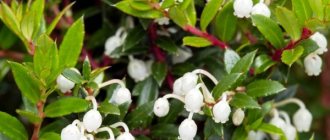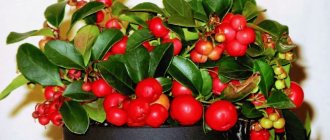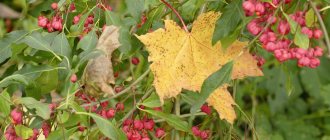Fruits and berries » Grapes
0
969
Article rating
Kira Stoletova
Vinegrass is an ornamental plant that resembles ivy in appearance but produces fruit similar to grapes. This is a vine-type crop that climbs walls and can create a hedge. There is aconite-leaved vineyard, short-peduncle vineyard and Ussuri vineyard.
Vineyard aconitifolia
Decorative coastal grapes
Coastal grape is a native of North America.
A powerful vine with 3-5 lobed, serrate-toothed, bright green shiny leaves. Flowers are dioecious. Small spherical berries are purple-black, with a thick bluish waxy coating, with colored juice, but sour and having a grassy taste, which explains their lack of demand in nutritional terms.
Coastal grape is a powerful, high-climbing vine. The antennae are intermittent. Large leaves are broadly ovate (8-18 cm), usually three-lobed.
Due to the aroma of the flowers, the Germans call it “mignonette grape.” Dim flowers are collected in inflorescences 8-18 cm long.
Grows along the banks of rivers in North America.
A distinctive feature of coastal grapes is significant frost and heat resistance. It tolerates temperatures down to -30°C and temperatures up to +40°C.
In addition, grapes are resistant to phylloxera, grow well when grafted, and are easy to take cuttings. If you use it as a rootstock, you must remember that the grapes on it bear fruit earlier and more abundantly when grown on good nutritious soil.
During hybridization and selection in order to obtain new grape varieties, this species is indispensable for the promotion of viticulture to the north and east. I.V. Michurin, by pollinating coastal grapes with pollen from Amur grapes, obtained an excellent frost-resistant variety “Buitur”.
The following varieties come from coastal grapes:
"Northern White"
"Northern Black"
"Taiga Emerald" ("Seedling Minnesota")
This species has been introduced into culture since 1656.
In the conditions of central Russia it freezes slightly, but recovers well; in the Primorsky Territory it also freezes slightly, but bears fruit.
The berries do not ripen every year, contain little sugar and are highly acidic. Seeds do not lose their germination capacity when the berries are fully ripe. This type of grape loves moist soils, so in dry years it grows weakly and its shoots ripen poorly.
The berries are purple-black with a thick, waxy coating, colored by juice and a grassy flavor.
In Moscow conditions, annual shoots freeze slightly, but grow back quickly. Photophilous. To care for ornamental grapes as the correct technology suggests, you need to ensure soil fertility. Does not tolerate lime in the soil. Relatively drought-resistant. Tolerates urban air pollution. Propagated by seeds, cuttings, layering.
Landing
Planting a vineyard can be done in spring or autumn. A hole is dug for each seedling, twice the volume of the earthen ball. The distance between the pits is from 0.5 to 1 m. Drainage is poured onto the bottom of the pit. A soil mixture is prepared in advance from leaf and turf soil with sand (in a ratio of 2:2:1). The seedling is placed in the hole and covered with soil. The earth is compacted and watered abundantly. When planting, you can fertilize the soil with superphosphate at a dilution of 1 tbsp. spoon on a bucket of water. The support is installed immediately. Hooks can be attached to the support, from which the vine can be removed before winter. Then the shoots will remain intact.
Advice: if the winters in the growing region are too harsh, it is recommended to plant the plant directly in a pot or container. Then it can be moved for the winter to a room with suitable wintering conditions.
Secrets of success
To grow a decorative, colorful liana or hanging plant, Ampelopsis is provided with a well-lit, cool place protected from drafts. In summer it is kept at a temperature of 17-20°C. You can take the plant out into the fresh air, shading it from the midday rays of the sun.
In winter they provide a lower temperature of 8-10°C.
There are seasonal differences in watering. In summer it should be plentiful, in spring and autumn - moderate, and in winter scanty, but sufficient to maintain the viability of the rhizome.
Popular types
Aconitofolia is a vine that grows up to 3 meters in height. The leaves are green on long petioles. The berries are initially yellow-orange and turn blue when ripe. The variety is winter-hardy. Its homeland is northern China.
Heart-shaped - the leaves of this species are not similar to the previous ones. They are heart-shaped, hence the name. The liana is powerful. The berries are greenish-blue.
Short-peduncle - a vine with dark green glossy leaves, growing in height up to 6-7 meters. Especially elegant variety "Elegance". It has green leaves with pink, creamy white strokes. And the berries are first green, then purple, and when fully ripe they look like scatterings of turquoise. Homeland - Primorsky Territory, China.
Variegated - the leaves of this species are also green and have different shapes, hence the name. It can grow up to 9 meters in height. The berries are light blue. Homeland - Korea, South Sakhalin, Kuril Islands.
In my garden there is a short-peduncle variety called "Elegance". It is less frost-resistant than all the previous ones.
For successful wintering, a secure shelter or growing in a container with wintering indoors is recommended. Can also be grown as a houseplant. In room conditions, this is a fairly docile vine that does not require much attention. Moderate watering, sufficient lighting and wintering in a cool room are all the requirements for successful cultivation.
My plant lives in the garden and has been wintering for 5 years, almost without shelter. Only the fallen leaves of the peach tree provide some protection.
At first I didn’t know that ampelopsis was not very winter-hardy, because it was given to me as a small cutting without any characteristics or name. Later, when I determined the name of the plant, I realized that there was no need for shelter. Winters normally. It grows in my garden as a ground cover plant. Of course, he would not have survived the winter on a support.
Vineyard - plant for garden collection
Hello, dear friends!
The Vinogradaceae family is famous not only for its valuable food species. Among its representatives there are also exclusively decorative crops. This includes a not very well-known, but very beautiful plant - the vineyard (Ampelopsis).
True connoisseurs and collectors are sure to strive to get it into their garden assortment. This interest is explained by the unusual beauty of the plant.
Biological features
The plant is a tall perennial vine, which in the natural conditions of North America, Central and East Asia reaches 9 meters. In areas with long frosty winters, ampelopsis rarely grows above 3 meters. The above-ground phytomass cannot withstand low negative temperatures and therefore in the spring the plant has to produce new shoots.
Small greenish flowers are collected in an inflorescence of a corymb or raceme. They do not add any special beauty to the plant. But the leaves are very decorative. They resemble grape leaves in shape, but the colors differ between species. The plant is deciduous, has long tendrils, with the help of which it clings to support.
The vine is also decorative during fruiting. Although its small berries cannot be eaten, they beautifully decorate the plant with their various shades: blue, lilac, turquoise, yellow, red.
Despite the fact that the crop in question and the grapes are related in the family, they cannot be crossed.
Types of vineyard
There are about 20 wild and cultivated species in this genus. Of these, several adapted species are most suitable for growing on a personal plot:
Vineyard variegated
In nature, it is most often found along the banks of rivers in the Far East. The developed garden form (V. watermelon) is distinguished by light blue and greenish-purple fruits. The leaf blades have a variety of shapes: whole, three- or five-lobed. The coloring of the leaves is very unusual - on a green background there is a complex white pattern that is not repeated on other leaves.
The species is not cold-resistant, therefore, if damaged by frost the next year, although it grows, it does not bear fruit.
Vineyard aconitifolia
After planting it grows very slowly, but after a few years it gains a lot of growth. The leaves are slightly shiny above and have slight pubescence and red veins below. Unripe fruits are yellow or orange in color, which changes to blue when ripe.
It is a cold-resistant species, but in the case of a very frosty winter, the flower buds may be damaged, so the plant needs reliable shelter.
Japanese vineyard
The plant has elongated leaf blades, shiny on top and bluish below. In autumn, the leaves of the vine acquire a beautiful red color. The fruits are bluish-violet, covered with dark dots.
In nature and culture, it often grows as a ground cover plant rather than as a hanging plant. In cold winters, the entire above-ground part may freeze out, but grows back in the spring.
In addition to the described species, V. grape-leaved, V. short-pedunculated, V. Bodinier, V. large-leaved, V. cordate and others are also of aesthetic importance.
Growing in the garden
Vineyards are easily propagated by seeds, cuttings, layering, and root shoots. If seeds are sown, the plants germinate safely, but bloom only after several years, so you have to wait a long time for spectacular fruiting.
When planting, you should leave at least 50 cm of free space between the plants themselves, as well as between the vine and the wall to be decorated. In the first years, young specimens are replanted annually, then this procedure is carried out once every 3-4 years. Ampelopsis requires fertile soil with good drainage.
When choosing a location, it is better to give preference to moderately lit or slightly shaded areas, since in the open sun the beautiful color of the leaves (for example, like that of a variegated vineyard) may disappear.
Since most species do not tolerate frost well, they must be covered for the winter with any suitable material. In the spring, before sap flow begins, the vines are pruned - this stimulates dormant buds and the growth of new shoots. Throughout the growing season, watering should be frequent and plentiful.
Ampelopsis can be successfully grown as a container and indoor plant. In this case, the vine is left in a cool (17-18°C) and well-lit room for the winter. Watering is reduced to a minimum. In the garden, all cultivated species are perfect for decorating the walls of houses, fences, and arches.
Features of planting and care
The plant needs good care
An ornamental plant needs care, just like a fruit-bearing plant. The main stages of grapevine care are planting, replanting, choosing a location (for open areas), pruning, propagation, and watering.
Planting in the soil
When planting in a container or pot, prepare soil containing:
- equal parts of garden and greenhouse soil, sand;
- manure;
- composted seaweed.
It is recommended to feed the vineyard from April. Use mixtures for indoor plants. For open soil, all types of fertilizers suitable for the vine will do.
Transfer
Potted crops are replanted every 2-3 years. If planted in open ground, caring for the plant remains the same. It tolerates wintering well if the vine is protected.
Crops in pots are put away in the cellar or brought indoors for the winter. It is not advisable to replant a plant in open ground.
Plot and pruning
They should be planted in shaded areas. In the sun, the leaves wither and lose color.
The crop does not require pruning. It is carried out only if you need to form a bush or direct the growth of a vine. Indoor plants are also pruned to stimulate growth.
Culture propagation
Ampelopsis is propagated through seeds (in fruits) or cuttings. Features of the methods:
- The seeds are extracted from the fruit and dried. The germination rate of planting material is high even when planted in open ground. A plant from a seed will begin to bear fruit only after 10 years. Can be stored for up to 4 years.
- A cutting with an internodal bud is taken from an adult bush. Rooting rate ranges from 80-85%. Such shoots bloom faster and bear fruit.
Pests and infections
The plant is sprayed regularly (1-2 times a week) against pests and infections. They are often affected by powdery mildew and mildew. Diseases appear as yellow spots on the leaves. Over time, the spots turn brown and the leaves fall off.
Causes of diseases:
- high humidity;
- lack of microelements and nutrients in the soil;
- infection from another culture.
Spotted mosaic is incurable, so the affected plants are destroyed. It is also worth keeping an eye on crops that have a similar list of pests.
Ampelopsis has many advantages
Ampelopsis aconitolifolia for many years without pruning
- Others, on the contrary, cut the shoots to the desired length every year in the summer after flowering or early spring (southern regions), keeping the vines within certain limits, or rather, contours.
- Vineyards are resistant to diseases and pests, so they are grown with virtually no treatments.
- Ampelopsis reproduce well by cuttings, layering, and stratified (1-2 months) seeds. When using long lignified stem cuttings, they are kept for 20-25 days in a humid environment at low positive temperatures, and root formation is improved with growth stimulants. Short, 10-12 cm long, stem, lignified cuttings of spring harvesting take root well in the same way.
- Ampelopsis are good in hedges using supports, decorating the walls of houses (using fixed trellises), and fences facing south and west.
But ampelopsis have one big disadvantage: they are not frost-resistant enough.
So here they are - my favorites.
Growing
Since Ampelopsis is a fast-growing plant, it is necessary to carry out radical pruning of the shoots every spring. This makes the specimen more decorative.
The vine is replanted as needed - every two to three years. Mineral fertilizers are applied twice a month during the period of active growth. Closer to the onset of cold weather, starting in September, the frequency of feeding is reduced to once a month and completely stopped in winter during the dormant period. Ampelopsis needs it for the subsequent spring growing season.
Description
Vineyard, whose second name sounds like ampelopsis, is a woody deciduous vine that is part of the Grape family. Although this genus unites about 20 species, it is customary to grow only two of them on the territory of the Russian Federation: aconite-leaved vineyard and short-pedunculated vineyard, also known as Ussuri. The first type is usually planted in Moscow, the Moscow region and the southern regions. The second requires more heat, so it feels better in the Lipetsk or Bryansk regions, but reacts poorly to dry air and elevated temperatures.
Plants, as a rule, have fibrous rhizomes and bark with tubercles. The antennae either lack suckers or are absent altogether. The leaf blades have a leathery surface and long petioles. Small green flowers are grouped into false umbrellas. The fruits of the vineyard are unsuitable for consumption and contain from 2 to 4 seeds. The shade of the berries varies from green to orange and purple, so it is they, unlike the buds, that are responsible for the decorative appearance of the crop. Smooth seeds have an oval shape. Thin shoots are colored purple.
Short-peduncle vineyard (Ussuriysky)
This species is most similar to a true grapevine. Description of the plant:
- red thin shoots;
- leaf cut into 3 or 5 lobes;
- the foliage is similar to grapes, rough, wrinkled;
- The color of the berries ranges from turquoise to purple.
Previously, the Ussuri species was considered a variety of variegated plants. But the species differ from each other in the dissection of the leaves and color (in the case of variegated foliage, the foliage is uniformly green in color and more carved).
The temperature for the plant in summer should not fall below 18°C, and in winter - below 2°C. It blooms in June or July for 60 days.
Common types of vineyard
Vineyard aconitifolia
Listed in the Red Book, the aconitifolia vine (A. aconitifolia Bunge) came from Northern China. This vine is small, very elegant, woody. It will grow up to 3 m. The green leaves of this species are palmate-lobed, deeply dissected, glossy, with a bare top and a hairy bottom along reddish veins. The blades have large sparse teeth, the petioles are long. Young foliage is very showy because of its colorful color: shiny leaves are bright purple or reddish olive green. The flowers are small, greenish, form loose inflorescences, bloom for 70 days.
The berries of this species are initially yellow or orange, when ripe they turn blue, with a sickly sweet taste.
The first years it grows slowly, then faster, about 3 m in growth. Quite a winter-hardy crop. In ornamental gardening it is valued for its mosaic openwork leaves. It is good to use for decorating trellises, canopies, and low structures.
Bodinier Vineyard
This species of vineyard (Ampelopsis bodinieri) - Bodinier - grows in Central China.
Liana up to 6 m in size, with a rapid growth rate. Quite winter-hardy.
Vineyard short-flowered
Short-flowered vine (Ampelopsis brevipedunculata) is also called Ussuri. It grows naturally in China, Primorsky Krai, and Korea. This is a woody small vine that grows up to 7 m. The stems have light gray, sometimes slightly brownish bark. Young shoots of the vineyard are coarsely hairy and yellowish-red. The leaves are leathery, usually five- or three-lobed, with sharp notches between the lobes. The foliage is dark green, the lower part of the leaves is slightly lighter. The leaves of the Ussuri vineyard are wrinkled. Flowers are monoecious, dioecious, in broad thyroid panicles.
The short-flowered vineyard does not tolerate dry air and heat; it is moderately winter-hardy, therefore it is used for indoor or container decoration. Propagated by cuttings, seeds, and layering.
The variety of this vineyard “Elegans” is very decorative - the small leaves of the vine are covered with white and pink spots, and in the fall they become golden in color.
The fruits of the vineyard are pale lilac; by autumn they ripen and become turquoise.
Vineyard variegated
Variegated vineyard (Ampelopsis heterophylla) is found in the south of Sakhalin, Ussuriysk, the Kuril Islands, Japan, northeast China, and Korea. It can usually be seen in river valleys.
This vineyard is very interesting due to its beautifully dissected leaves and light blue berries. It is similar to the short-flowered vine, but its leaves have rounded indentations and the leaves themselves vary in shape from one plant to another. The liana is quite powerful, grows up to 9 m. It is good to use for vertical decorative landscaping.
There is a garden form of this vine - watermelon vine (f. citrulloides hort.). It has berries of various colors: from blue to pale greenish-purple.
Reproduction methods
Vineyard propagation is quite simple. Most often, cuttings are chosen for this purpose, carried out in May or the summer season. Cuttings are cut from young shoots at the top of the vine, and then rooted either in wet sand or in soil under a plastic or glass cap. If the temperature is maintained at 20 degrees, the culture will take root in the near future. Preliminary use of a growth stimulator will only speed up this process.
You can also propagate a vineyard using layering. In this case, the shoot at the internode point is wrapped with either moistened moss or a soil mixture, and fixed on top with foil or cling film. If you provide the layering with regular moisture, you will soon be able to get roots, which means you can transplant the young vine to a new place. Propagation by seeds is recommended for those varieties of ampelopsis in which the leaf blades have an even green color. The seed requires pre-conditioning in a refrigerator at a temperature ranging from 0 to 2 degrees Celsius. Growing them will be successful if you provide the crop with ample lighting, nutritious soil and high humidity, which will be helped by a sheet of glass or cling film.
First steps after purchase
In flower shops, the plant looks like a small shrub or young vine on supports. It is recommended to carefully inspect the item you like before purchasing. If any damage to the leaf blades or small insects is noticeable, it is better to refuse the purchase.
Ampelopsis prefers bright, but diffused light, so on the first day after its acquisition, you need to create the usual conditions for successful growing season: place it on a western or eastern window. It is advisable to water the plant with settled water at room temperature, but do not flood it.
3.Varieties:
3.1.Japanese vineyard – Ampelopsis japonica
It is a vine with thin, flexible stems on which are palmately dissected, bluish-green leaves on long petioles. During the flowering period, this variety forms small inflorescences with small greenish flowers, which over time turn into round berries.
The plant is used in folk medicine as a medicine and is believed to have anticonvulsant, antibacterial, and expectorant properties.
3.2.Aconitifolia vineyard – Ampelopsis aconitifolia
A fast-growing deciduous vine with thin shoots and large, carved leaves. The leaves are palmate, arranged alternately, on long petioles. At the leaf nodes, the plant has thin, long, branched tendrils, with the help of which it clings and quickly entwines any support. In the second half of summer, the plant forms inflorescences with green flowers and decorates itself with small, bright berries in the fall.
3.3. Variegated vineyard - Ampelopsis heterophylla
A perennial, fast-growing, deciduous plant with thin, hard shoots that become lignified with age, 7–9 m long. The leaves are green, glossy, palmate, alternate. The antennae are thin, long, located in leaf nodes. The flowers are small, unattractive, collected in inflorescences - umbrellas. The real decoration of the plant will be small round berries in white, purple, blue, pink, and lilac shades.
3.4. Short-peduncle or Ussuri vineyard – Ampelopsis brevipedunculata
Deciduous decorative vine with flexible stems 4–6 m long. The leaves are green, mostly three-fingered, with small denticles along the edge of the leaf blades. Inflorescences - axillary umbrellas with greenish flowers are replaced in the fall by clusters of small berries of various shades.
3.5.Glandular vine – Ampelopsis glandulosa
A perennial deciduous climbing plant with shoots about 5 m long. The leaves are glossy, green, arranged alternately, the leaf blades are palmately dissected. Inflorescences are axillary umbrellas of many small, inconspicuous flowers. In autumn, brightly colored round berries appear on the plants, collected in small ones.
You might also be interested in:
Ampelopsis short-peduncle
Ampelopsis brevipedunculata is a resilient deciduous vine up to 5 m high, native to Northeast Asia.
Ampelopsis short-peduncle, photo by Anton Papkov Its leaves are broadly oval, 3-5-lobed, 5 to 12 cm long. The flowers are small, inconspicuous; bloom in July. The berries are small, spherical, first pinkish, then blue, with a diameter of 5-8 mm; ripen in August-September. Its decorative form 'Elegans' (leaves with a white marble pattern) is interesting.
Ampelopsis short-peduncle, Elegans form, photo from Pinterest
Ampelopsis short-peduncle is best used in vertical gardening in the southern regions.
Diseases and pests
Ampelopsis in indoor form often suffers from aphids, whiteflies and scale insects. The most common diseases on the vine are fusarium, rust and gray rot. But usually problems with vineyards arise only with serious violations of care, in particular, with improper watering. It is best to deal with problems immediately by using insecticides and fungicides.
READ MORE: Wireless karaoke microphones how to use How they work Portable professional and other models Rating of good microphones
Thrips, spider mites.
Vineyard
Botanical name: Ampelopsis.
Vineyard liana - origin. Eastern China.
Description. Vineyard or Ampelopsis includes 25 species of woody, very fast-growing deciduous perennial vines, native to North America and Asia, ranging in height from 3 to 7 meters. The leaves are alternate, simple or pinnately divided, 3–5 lobed, green or variegated white with coarsely serrated edges, shiny, 9–12 cm long. It has antennae at the base of each leaf, with the help of which it climbs a wall or clings to a support. Young branches are usually pubescent. The flowers are tiny, inconspicuous, greenish-white, appear in the summer (from June to August) and are collected in axillary inflorescences - complex umbrellas. The berries are slightly fleshy, 5–8 mm in diameter, black, bluish, greenish, each containing 2–4 seeds.
Height. Up to 7 m.
1.1.Reproduction, growing from seeds
Propagated in the spring by apical cuttings about 5 cm long, which take root in the soil at a temperature of 15 - 20 ° C. Seeds are sown in the fall.
1.2.Containment temperature
In spring and summer, normal room temperature is suitable for growing the vineyard. The plant overwinters in cool conditions, but not in the cold.
1.4.Care, pruning
The plant sheds its leaves in the winter and grows new ones in the spring; to do this, it should be heavily pruned. In summer it is recommended to take the plant out into the air. Requires support for growth. Flowers appear on new growth, so pruning in late winter (optional) helps control the size of the plant and maintain the desired shape.
1.5.Soil
Grows in well-drained soil and adapts well to most soils, including sandy or rocky ones.
1.9.Water the vineyard
Watering the vineyard: abundant in summer. Allow the top layer of soil to dry out between waterings. Plants overwintering in a very cool place are not watered at all.
1.11.Pests and diseases
Mealybugs and red spider mites.
Purpose.
Note: In indoor conditions, life expectancy ranges from 5 to 10 years.
Hydroponics. Grows well in hydroponic culture.
2.1.Japanese vineyard – Ampelopsis japonica
It is a vine with thin, flexible stems on which are palmately dissected, bluish-green leaves on long petioles. During the flowering period, this variety forms small inflorescences with small greenish flowers, which over time turn into round berries.
The plant is used in folk medicine as a medicine and is believed to have anticonvulsant, antibacterial, and expectorant properties.
2.2.Aconitifolia vineyard – Ampelopsis aconitifolia
A fast-growing deciduous vine with thin shoots and large, carved leaves. The leaves are palmate, arranged alternately, on long petioles. At the leaf nodes, the plant has thin, long, branched tendrils, with the help of which it clings and quickly entwines any support. In the second half of summer, the plant forms inflorescences with green flowers and decorates itself with small, bright berries in the fall.
2.3. Variegated vineyard - Ampelopsis heterophylla
A perennial, fast-growing, deciduous plant with thin, hard shoots that become lignified with age, 7–9 m long. The leaves are green, glossy, palmate, alternate. The antennae are thin, long, located in leaf nodes. The flowers are small, unattractive, collected in inflorescences - umbrellas. The real decoration of the plant will be small round berries in white, purple, blue, pink, and lilac shades.
2.4. Short-peduncle or Ussuri vineyard – Ampelopsis brevipedunculata
Deciduous decorative vine with flexible stems 4–6 m long. The leaves are green, mostly three-fingered, with small denticles along the edge of the leaf blades. Inflorescences - axillary umbrellas with greenish flowers are replaced in the fall by clusters of small berries of various shades.
2.5.Glandular vine – Ampelopsis glandulosa
A perennial deciduous climbing plant with shoots about 5 m long. The leaves are glossy, green, arranged alternately, the leaf blades are palmately dissected. Inflorescences are axillary umbrellas of many small, inconspicuous flowers. In autumn, brightly colored, round berries appear on the plants, collected in small clusters.
You might also be interested in:
Indoor gardening career
Among the representatives of the Vinogradov family there are many plants that successfully combine garden and indoor careers.
But even against their background, the vineyard, or ampelopsis in scientific terms, deserves special attention. Known here as “porcelain berries,” the plants in the West are called BlueBerry Vine or Porcelain Berry. This crop, which is actively used in landscaping in North America and Europe and can decorate any garden in regions with mild winters, is mainly known in our country only in indoor or potted culture. At best, vineyards are used to decorate gardens for the summer, returning them indoors for a period of rest.
https://www.youtube.com/watch?v=ytpolicyandsafetyen-GB
And ampelopsis cannot be called a very popular houseplant. But he deserves much more respect. This crop is very easy to grow, and it also allows you to change its shape and contours, easily adapting to different decorative tasks. Thanks to shaping and pruning, growing on and without supports, ampelopsis can grow in compact bushes, and not just in the form of luxurious thick ampels or wall drapes. And in the beauty of lacy greenery, no other indoor vine can compete with it.
The short-peduncle vine (Ampelopsis brevipedunculata), which today botanists have reclassified as the species of the ferruginous vine (Ampelopsis glandulosa), is sold in our country under the old name, and sometimes as Ussuri ampelopsis. This is the most common plant among vineyards, a very flexible vine with reddish-purple shoots up to 2-3 m long, so thin that it seems amazing how, with such a length, they can support a mass of densely arranged leaves.
Unlike real grapes, ampelopsis produces tendrils that are not equipped with suction cups, and it needs help to attach to any support. Whole, five-parted, deeply cut, leaves resembling a hybrid of ivy and grapes with very impressive large teeth along the edge seem surprisingly delicate and variable.
Leaves of very different sizes and shapes are often combined on one plant. But the most attractive part of ampelopsis is definitely its color. White, pink or even reddish spots randomly appear on the dark green, muted-colored leaf blade. Due to the unevenness of the variegated pattern, it seems as if paint was simply sprayed onto some of the leaves of the plant with a brush.
It blooms with inconspicuous and almost inconspicuous shields. Indoor ampelopsis, unlike garden ampelopsis, is not easy to wait for fruiting, since it produces spectacular berries only at a considerable age. But the spectacle is worth it. The fruits, although inedible, seem to be perfectly round balls, as if sculpted from porcelain.
Uneven ripening leads to the fact that the plant simultaneously contains berries with completely different colors from rich azure to blue, pink, white, blue, ultramarine and violet. And small specks only emphasize the non-standard colors. It is difficult even for recognized indoor berry soloists to compete with ampelopsis in the variety of colors and beauty of berries.
READ MORE: Fireplace doors 44 photos fireplace doors with glass glass doors made by yourself
In addition to the base plant, the Maksimovich form (Ampelopsis brevipedunculata var. maximowiczii) with lighter leaves, deeply cut into 5 lobes and an uneven edge, is also very popular. Maksimovic's vineyard produces smaller leaves that always fall off in the fall. The pattern on the leaves is not white-green, but pink-white-green, reminiscent of marble veins.
Collection, preparation, storage and recipes
The medicinal raw materials of the vineyard are the roots. They are harvested outside the active growing season - in March or October. When harvested in the wild, some plants are left untouched to restore the population.
The roots are cut into pieces 5-6 cm long, laid out on a baking sheet in a thin layer and dried in dryers at a temperature not exceeding 55 degrees. Finished raw materials are stored in paper or cardboard boxes for no more than 3 years.
Before preparing the preparations, the roots are crushed with a coffee grinder in coarse grinding mode.
The most famous are 2 recipes based on the vineyard:
- Decoction. Pour two tablespoons of crushed plant roots into a glass of boiling water and simmer in a water bath for half an hour, then leave for another 2 hours. The strained and cooled decoction is taken in a third of a glass 2 times a day before meals for syphilis.
- Ointment. Five tablespoons of crushed ampelopsis roots are added to 200 g of pork fat, placed in an enamel container, brought to a boil, then cooled without ceasing to stir. Used as a rub for joint pain.
The medicinal raw materials of the vineyard are the roots.
The king of noble drinks - grapes - has many relatives who are not inferior to him in decorativeness. Among them is ampelopsis - a bright, elegant vine that can decorate an apartment, office and garden plot with graceful, color-changing foliage and “porcelain” berries.
How to properly care?
Caring for a crop may seem difficult for a novice gardener, but it will not cause any difficulties for an experienced specialist. Separately, it should be mentioned that the vineyard is grown not only in open ground, but also in apartment conditions. In principle, the care process in this case is not too different, but there are still some specifics. For example, houseplants should live in containers and pots whose height is greater than their diameter. The container should not be too wide, since the powerful and deep-lying rhizome does not develop well in such conditions.
Young domestic vines need to be replanted every year, but for mature ones, a procedure performed once every 3 years will be sufficient. This is done in early spring with the appearance of the first signs of growth. Transplantation should be carried out using the transshipment method, that is, while preserving the earthen clod. The bottom of the pot must be covered with a drainage layer.
Watering
While ampelopsis is developing, it should be watered frequently and quite abundantly. However, the crop does not tolerate either a lack of moisture or its excess, so it is better to stick to the “golden mean” and maintain a stable regime. Drought causes the bush to shed its leaves, and stagnation of moisture leads to rotting of the roots. Almost from March to November, the crop should be watered abundantly and immediately after the first centimeter of soil dries out.
Top dressing
In order for the culture to actively develop, it needs to be fed regularly. Typically, fertilizers are applied every couple of weeks. Ready-made mineral complexes are best suited for the vineyard. Fertilizer application can continue from April almost to October.
Trimming
Ampelopsis tolerates pruning well, which, in turn, not only improves the appearance of the vine, but also promotes denser and more luxuriant flowering. If the shoots are greatly shortened, the vine will begin to grow better and even branch. In addition, timely formation allows you to change the dimensions of the crop in the required direction and change it almost to a potted state. The vineyard also requires a garter on supports, since the absence of tendrils leads to the fact that the plant is not able to “crawl” upward on its own. Curly bases, trellises, cascades, and even ordinary stairs are suitable for this.
Caring for a vineyard at home
Growing a vineyard is a simple process. It will need attention, in particular, regular watering without extremes. But despite this, ampelopsis cannot be classified as a capricious crop. Active care during the growing season and more modest care in winter will allow you to decorate the interior with the luxurious leaves of this crop. This is a light-loving and cool-wintering plant that tolerates pruning well and responds gratefully to minimal care.
Ampelopsis is rightfully considered a light-loving vine. This plant loves good lighting and feels comfortable both on eastern or western windowsills, and in a bright place with dim lighting. The vineyard needs to be protected from direct sunlight only in summer, and even then it is only afraid of the midday sun.

